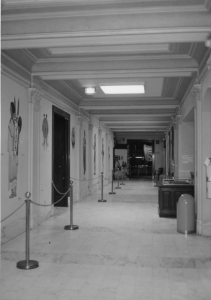Description
This is a three story Classical Revival style building with raised basement. This building has been listed in the National Register since 1990. It was at the time of the murals creation the Oklahoma Historical Society Building until early 2000s where the Historical Society received a new building at 800 Nazih Zuhdi Dr, Oklahoma City so named the Oklahoma History Center. Current the Oklahoma Judical Center also known as the Wiley Post Historical Building. Located on the third floor of the building is ten murals depicting Native-American figures, shields and other art work completed by two members of the Kiowa Five, Monroe Tsatoke and Spencer Asah.
Spencer Asah created in 1937:
- Choctaw 1843
- Secotan 1650
Monroe Tsatoke created due the 1930s:
- Kiowa 1920
- Cheyenne 1832
- Kiowa 1832
- Osage 1839
- Kiowa 1900
- Shield Designs (2)
- Comanche 1880
With the exception of Asah’s Secotan 1650, each mural depicts a tribe of Native-Americans of the Indian Territory at a specific moment in history with a great deal of attention given to details of formal dress. Most the the dates involve significant moments of interaction and negotiation with Europeans, Americans, and other tribes. This selection of dates also suggests a subtle political interest in the transformation of native life under the influence of outsiders. Tsatoke’s images of the Kiowa show the tribe in 1832 when the Stokes Commission first began to contact the tribes living in Oklahoma region on orders from Congress; in 1900 the United States included Indian Territory in the census; and in 1920 when another major census took place. The images describe Plains dress at the time of the American contact, dress during the reservation period, and the powwow dress often worn by the Kiowa artists, respectively. Tsatoke also includes two neighboring tribes – the Cheyenne and the Comanche. He chose to date of the Stokes Commission for his image of the Cheyenne but selected 1800 for the Comanche, possibly in reference to cessation of hostilities between the latter and the Kiowa. Finally Tsatoke included two decorative touches in his mural cycle in the form of two shield designs that are most likely Kiowa in origin.
Asah’s murals take a similar approach but he directed his attention to tribes from eastern North America: the Choctaw and Secotan. His image of the Choctaw in 1843 is drawn directly from George Catlin’s 1834 image of the Choctaw stickball champion Drink the Juice of the Stone, and the Kiowa artiest probably relied on one of the printed portfolios of Catlin’s paintings for inspiration. Asah’s dating of 1843 is puzzling in this context, however, and it is possible that the artist transposed the numbers. His image of the Secotan is most likely drawn from the pictorial accounts of John White, who helped establish the colony of Roanoke. White’s watercolor drawings were engraved and distributed in the 1590s by Theodore de Bry. Asah’s dating is problematic once again, although the artist may have intended to refer to the period of greatest interaction between the Secotan and Europeans.




Leave a Reply